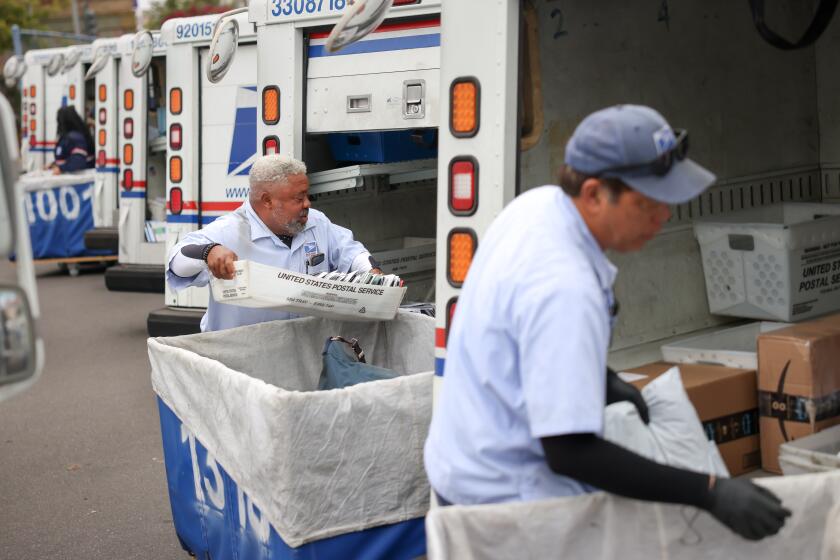Proud Neighborhood Lives Up to Its Reputation : Tepito Refuses to Yield to Devastation
- Share via
MEXICO CITY — “On Our Feet and Fighting,” reads the sign spray-painted on a sheet hanging on a cracked adobe wall in Tepito.
“Tepito Lives!” proclaims another of the banners seen at almost every corner of one of this city’s oldest and toughest neighborhoods.
At its renowned flea market, where street stalls, passed down from father to son, line entire city blocks and where pickpockets abound, “They can steal your socks without even taking your shoes off,” a longtime resident said, laughing.
But the area is also known for the unity of its resident merchants, who have lived here for generations. And in the chaotic aftermath of last week’s devastating earthquakes, Tepito has lived up to its reputation.
‘Gotten Together’
“We’re a family here,” said Alberto Jimenez, 51, a merchant born in the area whose father is a native as well. “Everyone’s gotten together to help those whose homes have fallen.”
Thousands left homeless have refused to move to the emergency shelters provided by the government and private groups throughout the city. Partly, they fear that their furniture and merchandise will be stolen from their damaged homes if they do not keep watch on them. But they are also stubbornly determined to stay in Tepito simply because it is their home.
“People don’t want to go to the shelters because they’re afraid that the authorities will use it as a chance to fragment the community,” said Felipe Ehrenberg, a volunteer organizer at one of the emergency centers in the area.
There is a longstanding feud between the community and the authorities over black-market goods sold in the area, he said, because “we have our own economic system which the authorities cannot get their hands on.”
Fear of Demolition
Many residents expressed fear that if they left their homes, the government would demolish them and not allow residents to return.
As a result, makeshift tents have sprouted like mushrooms along the streets normally crowded with commercial stalls. Merchants not personally affected by the quake have lent old plastic and cloth tarpaulins to their less-fortunate neighbors.
“We’re waiting to see if the government is going to help us to rebuild so we won’t have to move,” said Berta Morena de Ledesma, 43, stirring a large pot of soup over a kerosene stove. Several women were helping prepare the meal in a makeshift tent across the street from their evacuated apartment building.
All along the street, residents busied themselves in tents made of squares of plastic tarps, sheets and serapes but furnished with beds, sofas, tables, chairs, dressers, small coal-burning stoves and even television sets run off car batteries.
Pulling Up Water
Throughout the day, teen-age boys manned posts at uncovered manholes, where they dipped buckets at the ends of ropes and pulled up water for distribution to women who crowded around them. At a tiny park nearby, a dozen or so women knelt to wash clothes and dishes in a scene reminiscent of rural Mexico.
The community’s residents, already organized into building and merchants’ associations, have united to seek earthquake relief from the government.
Residents in some parts of the general area of about 400,000 say they are satisfied with the response from authorities in trucking in drinking water, providing emergency food and surveying the damage.
Waiting for Surveyors
But Ehrenberg, the emergency center volunteer, complained, “We’re into the seventh day since the catastrophe, and the government still hasn’t sent in surveyors to let us know whether it is safe to move back into some of the buildings.” He estimated that three out of five residents in central Tepito are homeless.
“What we need now are tools--shovels and wheelbarrows--and trucks to help clear the rubble,” he added.
A taxi driver who lives in the neighborhood said, “We’re just waiting for the authorities to come in and tear down the buildings so we can go back in and start building and set up our households and go back to work.” The driver’s present home is a tent in the middle of a street.
Aid From Private Donors
Residents have organized makeshift centers for distribution of food, clothes and medicine delivered by private donors.
“With our own neighborhood organizations, we’re doing for ourselves what the state can’t or won’t do,” Ehrenberg said, adding that his center feeds about 2,000 people a day. He said the government has stopped sending emergency food supplies to Tepito.
Neighbors have also pitched in to help clear rubble from damaged homes. On Wednesday, men and women could be seen mixing cement and laying bricks at some sites.
“We’re proud of our community because we didn’t come here yesterday or day before but have been here for generations,” said Enrique Duran, 40, who lives and works on a street well-known for the sale of contraband television sets and other electronic goods.
“We have more than enough hands willing to help with the repair work. And after that we will continue working like we did before. This is nothing more than a recess.”
More to Read
Sign up for Essential California
The most important California stories and recommendations in your inbox every morning.
You may occasionally receive promotional content from the Los Angeles Times.










